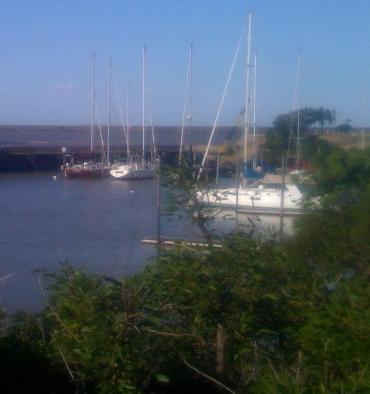 After a pleasant trip up the Rio de la Plata, we docked at the well-appointed facilities of the exceptionally helpful and hospitable Yacht Club Argentino. Buenos Aires is a very pleasant and exciting city to be in. People are quite relaxed and friendly.George is now flying back to his home and boat in Southport, North Carolina. I am in the process of arranging to haul the boat out of the water and get a bunch of work done. I expect to be in this area for the next 2-3 months.
After a pleasant trip up the Rio de la Plata, we docked at the well-appointed facilities of the exceptionally helpful and hospitable Yacht Club Argentino. Buenos Aires is a very pleasant and exciting city to be in. People are quite relaxed and friendly.George is now flying back to his home and boat in Southport, North Carolina. I am in the process of arranging to haul the boat out of the water and get a bunch of work done. I expect to be in this area for the next 2-3 months.
Monthly Archives: November 2008
Rio de la Plata, Argentina
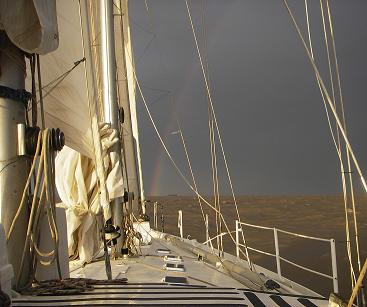 We had a great tailwind for the sail up the Rio de la Plata to Buenos Aires. The river (Rio de la Plata) is mostly shallow, especially the farther up one gets, and full of shipwrecks that must be avoided (most of which are marked by cardinal buoys). Because the river is shallow, the waves do not get high, but get steeper instead, so we kept the dropboard in and the hatch closed much of the time to keep the occasional breaking wave from splashing inside the boat. On our last night, we ended up spending most of the hours of darkness tacking back and forth, trying to keep the boat in place, rather than let the tidal current carry us further up the river. This was done to delay our entrance to Buenos Aires until daylight.
We had a great tailwind for the sail up the Rio de la Plata to Buenos Aires. The river (Rio de la Plata) is mostly shallow, especially the farther up one gets, and full of shipwrecks that must be avoided (most of which are marked by cardinal buoys). Because the river is shallow, the waves do not get high, but get steeper instead, so we kept the dropboard in and the hatch closed much of the time to keep the occasional breaking wave from splashing inside the boat. On our last night, we ended up spending most of the hours of darkness tacking back and forth, trying to keep the boat in place, rather than let the tidal current carry us further up the river. This was done to delay our entrance to Buenos Aires until daylight.
La Paloma, Uruguay
 The beach at La Paloma
The beach at La Paloma
La Paloma, Uruguay
34 40’S:54 10’W
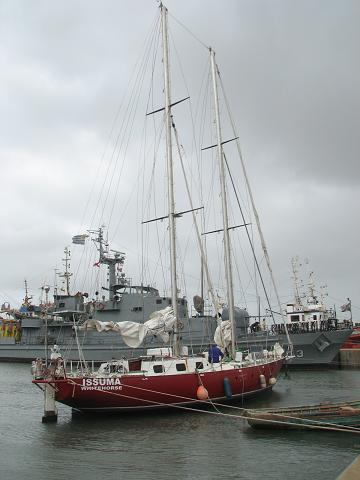 To sit out a pampero (strong SW wind in the Rio de la Plata area) Saturday, we came into La Paloma, Uruguay. We were having intermittent problems with the engine. I’d changed one fuel filter (which appeared fine), and suspected the other two needed to be changed, but was hoping to get the boat into port before doing so. By the time we got close to the port, the wind was about 25 knots, and we were motorsailing, noticing the engine was having a lot of trouble. There wasn’t a good place to anchor, and it was bouncy enough, in an increasing wind, and we were tired enough to not want to try changing the fuel filters right there. Traffic Control in the port had earlier told us we would go to a mooring when we arrived, and to call back when we were closer. Just outside the entrance to the harbor, after dropping the one sail we had up, and motoring into flat water, we called to say we were about to enter, and they told us we were to go to a dock. There followed a mad scramble to get docklines and fenders ready. The engine had lost a lot of power, and I really wanted to get tied to the dock quickly, before it failed. As it turned out, just downwind of the dock, the engine stopped, and both docklines that were thrown missed. As we blew off downwind, I restarted the engine, and found it did not have the power to retry getting upwind to the dock. I asked if we could take a mooring, and they said we could. We had trouble getting the anchor ready to drop (wanted the anchor ready in case we couldn’t reach the mooring), as the winch had become very difficult to turn after getting sprayed with salt water for the last six weeks at sea. George managed to get the anchor chain out of the locker without the winch as I approached the mooring buoy. I couldn’t make the turn into the wind sharply enough with the power I had to clear a nearby boat, so I eased off the throttle for another attempt. Upwind, on the foredeck, George interpreted this as we were unable to make headway, and dropped the anchor. This was just as well, as the anchor held us away from the rocks that were 100m downwind. The prefectura (harbor master) was very helpful, and came out with their launch and towed us to the dock. There was a Uruguayan navy ship nearby, and several sailors came out to assist. We got lines on the dock from about 6m (20 feet) away, but then the keel, which was locked down, went into the mud and we stopped. The keel is raised by a winch pulling a steel cable around some pulleys. Unfortunately, the cable broke when we tried to raise the keel. So we settled into the mud, 6m off the dock. As we worked on replacing the winch cable (we had a spare), the prefectura kindly tied a wooden rowboat to the dock and to our boat, so that we could get to and from the dock. Two mechanics from a nearby fishing boat came over to help with the engine, and showed us that both the fuel filters were full of water and what seemed to be Sikaflex. The way the fuel system works on this boat is that fuel is pumped from the main tanks through a Racor water-separating fuel filter (which should take out almost all the water, and which I had changed, and which had only a little water in it), to a day tank. From the day tank, it goes to two more filters, one of which is also a water separating one with a metal bowl (so you can’t see the water by looking at it). These two filters were the ones which had the majority of the water in them. The day tank is an old plastic tank, and it had been repaired earlier with some kind of sealant, but had started to leak. We had patched it up with Sikaflex (a sealant), but it appears that the fuel dissolved some of the Sikaflex we put in and some of it ended up in the filters. Draining the water and replacing the filters solved the problem, and the engine was running well again.After replacing the winch cable, we got the keel up, and several navy men assisted us in pulling the boat closer to the dock. So we got the warm welcome that visitors are assured of (according to the crusing guide) when visiting Uruguay. People are exceptionally nice here, and it is quite a pretty seaside resort area. It is quiet now, just getting ready for summer, which starts next month.
To sit out a pampero (strong SW wind in the Rio de la Plata area) Saturday, we came into La Paloma, Uruguay. We were having intermittent problems with the engine. I’d changed one fuel filter (which appeared fine), and suspected the other two needed to be changed, but was hoping to get the boat into port before doing so. By the time we got close to the port, the wind was about 25 knots, and we were motorsailing, noticing the engine was having a lot of trouble. There wasn’t a good place to anchor, and it was bouncy enough, in an increasing wind, and we were tired enough to not want to try changing the fuel filters right there. Traffic Control in the port had earlier told us we would go to a mooring when we arrived, and to call back when we were closer. Just outside the entrance to the harbor, after dropping the one sail we had up, and motoring into flat water, we called to say we were about to enter, and they told us we were to go to a dock. There followed a mad scramble to get docklines and fenders ready. The engine had lost a lot of power, and I really wanted to get tied to the dock quickly, before it failed. As it turned out, just downwind of the dock, the engine stopped, and both docklines that were thrown missed. As we blew off downwind, I restarted the engine, and found it did not have the power to retry getting upwind to the dock. I asked if we could take a mooring, and they said we could. We had trouble getting the anchor ready to drop (wanted the anchor ready in case we couldn’t reach the mooring), as the winch had become very difficult to turn after getting sprayed with salt water for the last six weeks at sea. George managed to get the anchor chain out of the locker without the winch as I approached the mooring buoy. I couldn’t make the turn into the wind sharply enough with the power I had to clear a nearby boat, so I eased off the throttle for another attempt. Upwind, on the foredeck, George interpreted this as we were unable to make headway, and dropped the anchor. This was just as well, as the anchor held us away from the rocks that were 100m downwind. The prefectura (harbor master) was very helpful, and came out with their launch and towed us to the dock. There was a Uruguayan navy ship nearby, and several sailors came out to assist. We got lines on the dock from about 6m (20 feet) away, but then the keel, which was locked down, went into the mud and we stopped. The keel is raised by a winch pulling a steel cable around some pulleys. Unfortunately, the cable broke when we tried to raise the keel. So we settled into the mud, 6m off the dock. As we worked on replacing the winch cable (we had a spare), the prefectura kindly tied a wooden rowboat to the dock and to our boat, so that we could get to and from the dock. Two mechanics from a nearby fishing boat came over to help with the engine, and showed us that both the fuel filters were full of water and what seemed to be Sikaflex. The way the fuel system works on this boat is that fuel is pumped from the main tanks through a Racor water-separating fuel filter (which should take out almost all the water, and which I had changed, and which had only a little water in it), to a day tank. From the day tank, it goes to two more filters, one of which is also a water separating one with a metal bowl (so you can’t see the water by looking at it). These two filters were the ones which had the majority of the water in them. The day tank is an old plastic tank, and it had been repaired earlier with some kind of sealant, but had started to leak. We had patched it up with Sikaflex (a sealant), but it appears that the fuel dissolved some of the Sikaflex we put in and some of it ended up in the filters. Draining the water and replacing the filters solved the problem, and the engine was running well again.After replacing the winch cable, we got the keel up, and several navy men assisted us in pulling the boat closer to the dock. So we got the warm welcome that visitors are assured of (according to the crusing guide) when visiting Uruguay. People are exceptionally nice here, and it is quite a pretty seaside resort area. It is quiet now, just getting ready for summer, which starts next month.
AIS
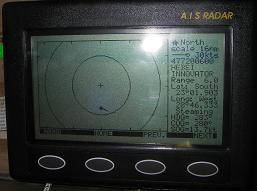 Earlier I mentioned AIS (Automated Identification System). This is a relatively new standard that involves ships transmitting name, position, course and speed information automatically. All ships over 300 tons are now required to have AIS transmitters. This basically means all cargo ships, but only the largest fishing vessels. We installed an AIS receiver in the Canaries. I bought the only one available there at the time, called an “AIS Radar” by the vendor, NASA Marine Ltd (a UK marine electronics company). The name is misleading, it has absolutely nothing to do with radar.On the screen, the cross in the centre is the receiver (my boat). North is up. The circle with a line behind it is the ship detailed on the right, the HEBEI INNOVATOR. The direction the line attached to the circle comes from gives you some visual idea of how close the ship will come to you. On the right you can see the course over the ground (COG), heading, speed, position and range (distance away) of HEBEI INNOVATOR. There is an alarm that sounds (usually) when a ship comes into range. Occasionally the unit will display a target, but never sound the alarm. It is not clear from the minimal instructions that came with the unit why the alarm does not always sound. Despite that, as long as you periodically have a look at the screen when in poor visibility, it does a great job of alerting you to the presence of ships. We usually are alerted by the AIS before we see the ships–typically they show up on the AIS when 12-16 miles away (mostly because the antenna is mounted fairly high up).
Earlier I mentioned AIS (Automated Identification System). This is a relatively new standard that involves ships transmitting name, position, course and speed information automatically. All ships over 300 tons are now required to have AIS transmitters. This basically means all cargo ships, but only the largest fishing vessels. We installed an AIS receiver in the Canaries. I bought the only one available there at the time, called an “AIS Radar” by the vendor, NASA Marine Ltd (a UK marine electronics company). The name is misleading, it has absolutely nothing to do with radar.On the screen, the cross in the centre is the receiver (my boat). North is up. The circle with a line behind it is the ship detailed on the right, the HEBEI INNOVATOR. The direction the line attached to the circle comes from gives you some visual idea of how close the ship will come to you. On the right you can see the course over the ground (COG), heading, speed, position and range (distance away) of HEBEI INNOVATOR. There is an alarm that sounds (usually) when a ship comes into range. Occasionally the unit will display a target, but never sound the alarm. It is not clear from the minimal instructions that came with the unit why the alarm does not always sound. Despite that, as long as you periodically have a look at the screen when in poor visibility, it does a great job of alerting you to the presence of ships. We usually are alerted by the AIS before we see the ships–typically they show up on the AIS when 12-16 miles away (mostly because the antenna is mounted fairly high up).
Picture update
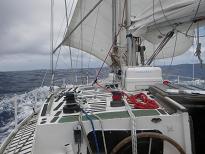 This is the picture I meant to include with the previous post (Another Pleasant Day Offshore).
This is the picture I meant to include with the previous post (Another Pleasant Day Offshore).
Another Pleasant Day Offshore
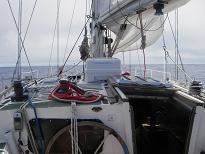 We’ve had nice tailwinds for the last few days. The breeze is dying out now (the picture is from yesterday), but it has been a nice stretch of pleasant, relaxing sailing in very nice conditions. We are expecting mostly light conditions (ie, often not enough wind to sail in) over the next few days.
We’ve had nice tailwinds for the last few days. The breeze is dying out now (the picture is from yesterday), but it has been a nice stretch of pleasant, relaxing sailing in very nice conditions. We are expecting mostly light conditions (ie, often not enough wind to sail in) over the next few days.
Heading Towards Argentina
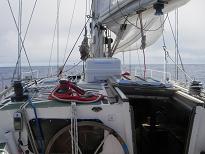 We are heading towards Buenos Aires, Argentina. We looked into going to Brazil, which was closer. Brazil had visa issues (we need visas for Brazil and don’t have them), and it doesn’t have as good facilities for working on boats as Argentina does. We might have been allowed into Brazil without visas on the grounds of needing repairs, but at this point, I’ve worked around the broken furler in all the wind conditions I expect we will see coming into Buenos Aires (which is not nearly as windy as South Africa, where we were originally going), so can’t really say we would need to go into Brazil for repairs. We still have a long way to go (about 1050 miles), but we are looking forward to Buenos Aires.I say we are heading ‘towards’ Buenos Aires, rather than ‘to’, because the sea has absolutely no respect for plans, and frequently causes changes in them. So it is best not to tempt fate by being too definitive about where the next destination will be. We motored yesterday in a flat calm, and now have a great wind from the port side pushing us along nicely in small seas, warm temperatures, and somewhat sunny skies.
We are heading towards Buenos Aires, Argentina. We looked into going to Brazil, which was closer. Brazil had visa issues (we need visas for Brazil and don’t have them), and it doesn’t have as good facilities for working on boats as Argentina does. We might have been allowed into Brazil without visas on the grounds of needing repairs, but at this point, I’ve worked around the broken furler in all the wind conditions I expect we will see coming into Buenos Aires (which is not nearly as windy as South Africa, where we were originally going), so can’t really say we would need to go into Brazil for repairs. We still have a long way to go (about 1050 miles), but we are looking forward to Buenos Aires.I say we are heading ‘towards’ Buenos Aires, rather than ‘to’, because the sea has absolutely no respect for plans, and frequently causes changes in them. So it is best not to tempt fate by being too definitive about where the next destination will be. We motored yesterday in a flat calm, and now have a great wind from the port side pushing us along nicely in small seas, warm temperatures, and somewhat sunny skies.
Birds
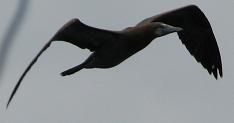 We see a fair number of birds, even hundreds of miles offshore. I am not sure what kind of bird this is, but they fly close to and around us often. We are in the Variable belt of winds and, true to their name, they are being very variable. Going has been slow for the last few days–wind direction has varied a lot, and wind speed has been 5 to 30 knots. We’ve been raising and lowering the fore-staysail (the sail with the broken furler) as necessary (hardly ever), and that has been working out well.
We see a fair number of birds, even hundreds of miles offshore. I am not sure what kind of bird this is, but they fly close to and around us often. We are in the Variable belt of winds and, true to their name, they are being very variable. Going has been slow for the last few days–wind direction has varied a lot, and wind speed has been 5 to 30 knots. We’ve been raising and lowering the fore-staysail (the sail with the broken furler) as necessary (hardly ever), and that has been working out well.